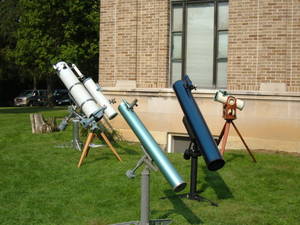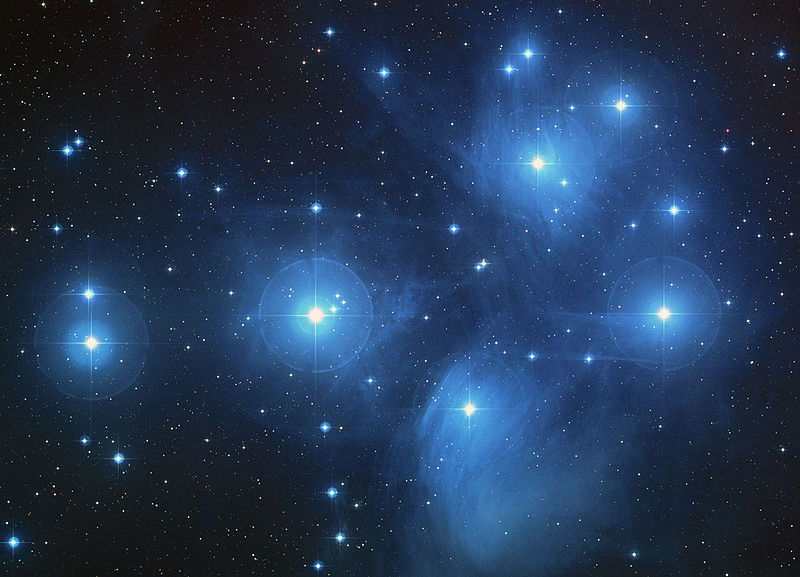Amateur Astronomers Assist Experts
Interview with
Chris - Here's a question: The universe is a big place and if you only have a small number of telescopes with which to look at it, and limited resources to analyse the data that you collect, inevitably lots of important questions will go unanswered. So how do you solve that problem? The answer is by professional astronomers teaming up with amateurs around the world and asking them to do some of the observing.
And that's exactly what Dr Pamela Gay from the Southern Illinois University, Edwardsville has been doing...
Pamela - I work with the American Association of Variable Star Observers which, while it has the name America in its title, is actually an international organisation of observers. We have people from all around the world. Amateurs who liked to go out in their back yard and look at stars and measure how bright they are. It sounds like just a fun game but for scientists this is amazingly powerful. I study a type of star called RR Lyraes. These are stars about 26 times the mass of the sun. They aren't stable and they get larger and smaller. They change in brightness as they do this. When Shakespeare said inconstant stars he was exactly right, they are inconstant. They do this over less than a day ad to fully understand them I actually need about a month's worth of data because the night is short and I can't always get the entire light curve; the entire change in brightness from light to faint.
Chris - Is that because there's competition for the telescope time so you can't literally hog it for that long to see the full periodicity of what these stars are doing?
Pamela - I can often hog it for one night but then the sun comes up before I'm done. If I can get, say, the first 60% of one light curve one night I might be able to get another 3% to 63%. I have to go there night after night for the star to cycle all the way around. They're not going to give me ten nights. If I observe in the United States and I can find an Italian astronomer with a telescope in his back yard to observe from there and I can find an Australian in his back yard (I'm sure it's far enough south that the Australian can see it) my star can get handed off around the globe from person to person.
Chris - So what's the idea here? You will recruit people who are doing astronomy as a hobby and get them into your project so they're contributing to your research?
 Pamela - Exactly. This is an opportunity for someone to take their hobby, their love of going outside and watching the stars and how they change, and actually contributing to our knowledge of how the universe works. The particular stars I'm working on aren't well understood and until we can observe probably about 100 of them in deep detail we can't make heads nor tails of them. We just know their behaving oddly.
Pamela - Exactly. This is an opportunity for someone to take their hobby, their love of going outside and watching the stars and how they change, and actually contributing to our knowledge of how the universe works. The particular stars I'm working on aren't well understood and until we can observe probably about 100 of them in deep detail we can't make heads nor tails of them. We just know their behaving oddly.
Chris - What are you asking these people to do and how do you know you can trust their data? As a scientist myself I'm a total perfectionist and unless I've done it myself I get terribly worried that it's not trustworthy. How do you get trustworthy data out of people you've never met?
Pamela - The trick is that you have to calibrate things in multiple directions. If I have a field of stars (and they can take a visual picture and capture four stars in it) one of them's my target star that's changing in brightness all the time. The other three are constants and if I know those other stars have values of 10, 10.4 and 11.
Chris - This is the brightness?
Pamela - This is the brightness. We measure brightnesses on a scale of 0 to as dark as it gets. 0's the brightest, the human eye cuts out about 6. You can get with a typical backyard telescope down to about 14 and the numbers just keep getting bigger. If I know for certain the numbers associated with three of the stars and I know the fourth one varies and their measurements of those three are bang-on the same the entire time I know I can trust the results.
Chris - You're asking people to send you pictures or just brightness measures of the same stars which you can then calibrate to use their results?
Pamela - What I asked them to do was take the images and make the measurements of this one is 10, this one is 11 and this is what your variable star is and just send me an Excel spreadsheet. Then I combine all these Excel spreadsheets. A couple of years ago I did a campaign. I got, in three months, over 8000 observations. They weren't all perfect but out of those 8000 data points I got several thousand that allowed me to solve a problem star that I'd been struggling with since 1992.
Chris - This is the astronomy equivalent of the CETI experiment where you're just analysing huge amounts of data that professionals couldn't have the time to trawl through. So you get people to just do something for you?
 Pamela - This actually takes that model and turns it on its head. With CETI at home; with Galaxy Zoo the scientists are acquiring all the data and then with CETI they're saying please let me abuse your CPU processor on your computer and it will tell me the analysis. With Galaxy Zoo they're saying, "we have all these pictures please can you do the analysis for me?" In my case I'm going, "I want to do the analysis but I don't have the data!" I'm asking them, " can you please use your telescopes to get me the data I need."
Pamela - This actually takes that model and turns it on its head. With CETI at home; with Galaxy Zoo the scientists are acquiring all the data and then with CETI they're saying please let me abuse your CPU processor on your computer and it will tell me the analysis. With Galaxy Zoo they're saying, "we have all these pictures please can you do the analysis for me?" In my case I'm going, "I want to do the analysis but I don't have the data!" I'm asking them, " can you please use your telescopes to get me the data I need."
Chris - Astronomer, Pamela Gay explaining how amateur astronomers can team up with professionals to do cutting-edge research. She was in Cambridge this week to take part in a meeting between the AAVSO (American Association of Variable Star Observers) and their UK counterparts, the British Astronomical Association. As luck would have it, I also managed to track down one of those amateur astronomers who's been helping Pamela with her research. I found him in the Castle pub.
Jerry - My name is Jerry Samolik, I live in Greenfield, Wisconsin, USA. My interest in astronomy probably started late 50s, early 60s with the beginning of the space programme. I still have an article in a magazine called Space Journal 1958 covering the launch of the first American Satellite. I guess I've been a fanatic since childhood!
Chris - You're just really interested in Astronomy and Space Science, you're not a professional but you do do a lot of this stuff.
Jerry - Correct. By profession I'm an engineer. I've been observing since I was in high school. In my back yard I've got one flip-top observatory with a 10" LX-200 ccd camera. The entire building is 3 feet by 4 feet so I can't get inside of it. It's just big enough to house the telescope. Once I get the thing sorted I set the autoguider up and I go to bed.
Chris - How many people in America and elsewhere in the world do you know of through your connections that do similar things to you, that are doing pretty high level astronomy but from the home?
Jerry - Well, a number of people is hard to count. We have three active observers in Italy, we have several in the United States - maybe half a dozen. We have one in Australia and what we try to do is coordinate our efforts. The Italian observer will get on a star. He'll send me an email that's still new in my time. He's telling me what he's observing so I can set up a target that evening. As the Earth rotates I'll carry the star across. For summer stars sometimes we can pass them along to Neil Butterworth in Australia so that we can get more than half a revolution of the planet and target it.
Chris - You're doing pretty high-level work. Do you struggle to get professionals to take you seriously though?
Jerry - I don't think so. The organisation I belong to, the AAVSO, has always been in very high regard of the professionals. It's always interesting going to the meetings because we'll have amateurs giving programmes and professionals listening to them.
Chris - So what are you looking at the moment?
Jerry - This time of year I'm working on a few RR Lyrae stars. I've got one I'm working on in Cancer. I'm just picking up on one area of Hercules that's just starting to come up in the evening that I can run throughout the night. That's been a star I've been observing visually probably since the 1980s. It's got a very interesting dual mode that pulsates. We've got kind of a handle on it but every so often I see something out of the ordinary and I'm just trying to see if that happens again.
Chris - That was Jerry Samolik explaining how amateur astronomers like him can make powerful contributions to science just by helping professionals with their observations. Pamela Gay who you heard before that was telling me that if you'd like to find out a bit more about the AAVSO, that was the body that he was a member of, then you can get involved with them. Their website address is AAVSO.org.
- Previous Zero Energy Housing
- Next The Science of Solar Flares










Comments
Add a comment